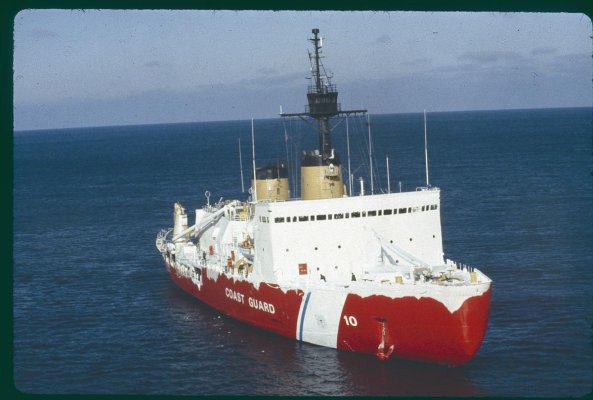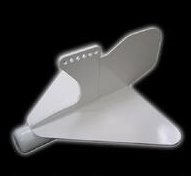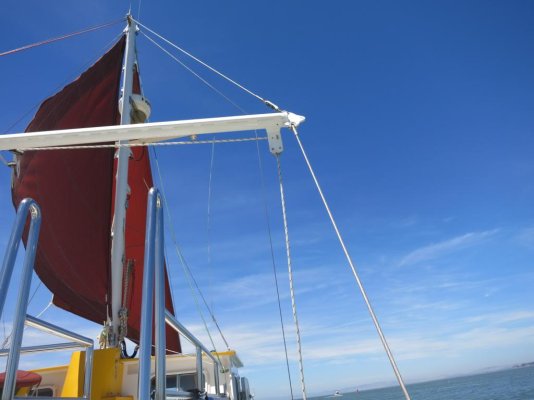do you have experience with anti roll tank system?
No, but I've been thinking about it for the last several days now that I'm snowed in. Given that limited amount of time, here are my thoughts.
Somebody posted about a relatively new small boat gyro system. I was all excited when I saw that it was 365 pounds. Turns out that is the weight of the gyro, not the cost. It is 16,000 U.S.D., not including installation, so figure $20K. It requires power, prime space, and time to spin up, but it is the price tag that gives pause. The stabilizing force for the gyro is given in the advertisements, and the videos are impressive. I haven't really compared the gyro to that of a passive anti-roll tank. However, if a passive DIY system cost 2% of the gyro ($1000), but had 18% of the stabilizing force, would it be worth it?
I'm going to leave out the naval architect calculations for the moment, both because I haven't done them and because I think that the simplest system could use valves that can be fine tuned after construction. I'd use trial and error more than calculator and prayer.
My interior beam in the engine room is about 11 feet. During a healthy roll of 15 degrees, one side would be 2.5 feet higher than the other. I might need to keep that in mind for the shape of my tanks, probably making them about that height. My boat has enough space to easily fit 20 gallon tanks on each side right behind the fuel tanks. Once my generator is removed, it would be clear from side to side across the engine room.
Let's say my hypothetical system is two 20 gallon tanks connected by 6 inch (maybe 8) PVC pipe. The PVC has
a ball valve for future fine tuning. One of the tanks has a fill (either fresh or salt given that everything will be PVC) to allow fine tuning the right amount. To start, the tanks are less than half filled, say 7 gallons. The 6 inch connecting pipe contains 1.5 gallons per foot, say 10 gallons. But at a 15 degree roll, one tank and half of the pipe (12 gallons) would run into the other tank, filling it to 19 gallons.
The problem has always been that the changing mass of the shifting water is too fast. Putting baffles in the crossover helps, and maybe the ball valve can help with that. It seems to me that a better approach might be to connect the top of the tanks with an air vent (as is usually done) and control the flow that way. Control it passively, as avoiding pumps and electronically controlled valves would be a large part of the appeal.
Say the air vent is a 2 inch PVC pipe that contains a simple throttle valve. On the throttle valve is a rare earth magnet. Outside the pipe is another magnet that is adjustable such that it can hold the throttle shut, but allows instant opening at various degrees of vacuum by varying the distance between the two magnets. As the water tries to shift from upper to lower tank, a vacuum builds in the upper tank because of the closed throttle valve, partially holding back the water until the vacuum is sufficient to overcome the magnetic attraction and pop, the valve flips open, allowing the water to surge into the lower tank moments later than a free flowing connection.
From what I've seen on the web, the "hold back" time required is less than 1 second for small boats. That seems possible based on my experience with rare earth magnets. I use them some in repairing dented saxophones (another hobby). When I first had a rare earth magnet on my workbench, I opened a drawer only to find all of my jeweler's screwdrivers had disappeared. It turned out that the magnet pulled them up out of the drawer and they were stuck to the underneath of the workbench. Holding back a little vacuum shouldn't be a problem.
As to calculating the amount of effect an anti-roll tank could have with such small amounts of water, the secret seems to be in timing the small amount of water. In my hypothetical, I'm only shifting 12 gallons of water (100 pounds) from beam to beam, so the key would be getting the timing perfect. I know that a 100# weight, if shifted perfectly from beam to beam every 1.725 seconds (or whatever my roll rate is) would really have a surprising effect after a few cycles. Question is would it have the same cancelling effect?



